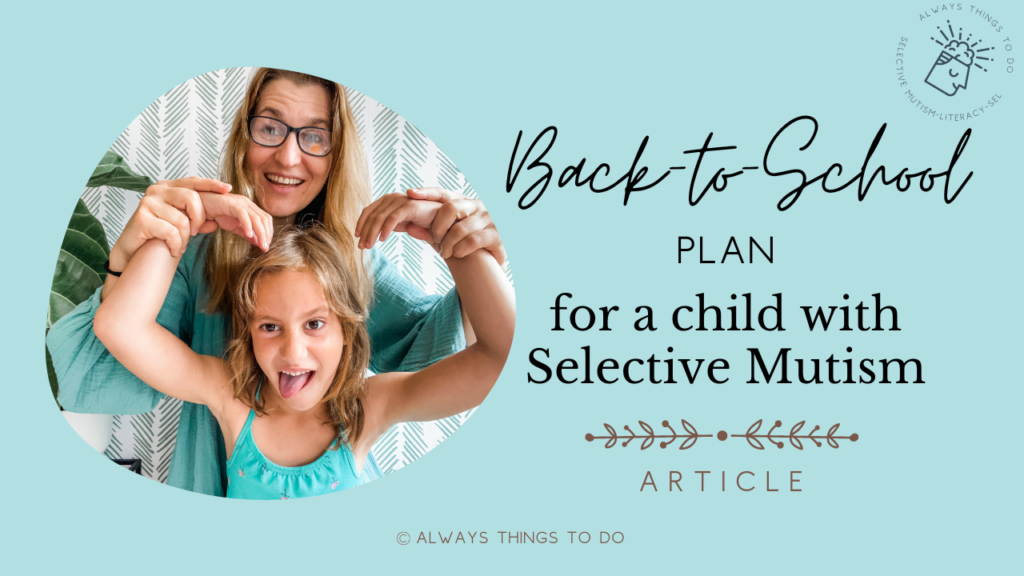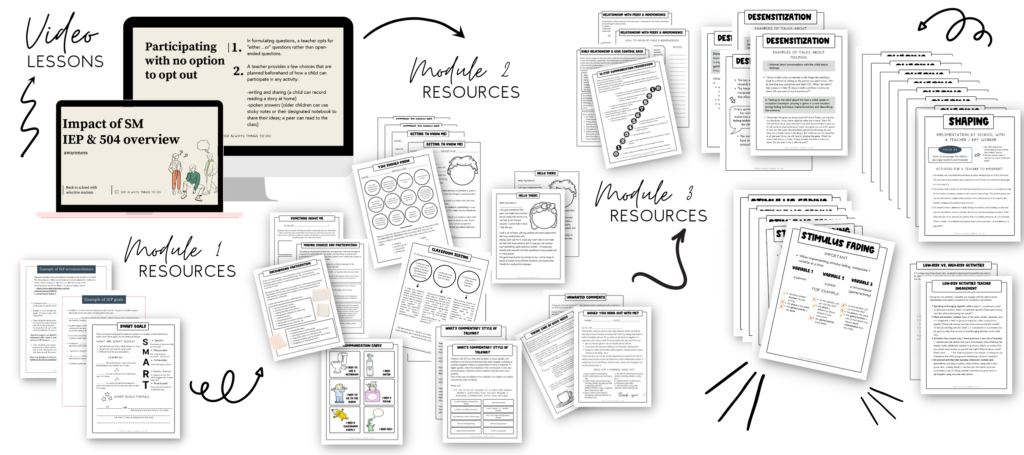Back-to-School Plan for Parents of a Child with Selective Mutism:Tips and Steps to Take.

In this article, you will read about essential tips for getting back to or starting school for a child with selective mutism.
Let’s be honest, the whole thing of “getting-back-to-school-successfully” seems like an “oh-gosh-here-you-go…” moment.
Whether your kiddo has made some or significant improvements in summer, or you are just starting to wrap your head around going back to school with selective mutism, you need to know this: for most kids and parents (just like it was for us) the beginning of school time will be a massive smack in the face. Oh yeah, I know it.
So, you might be thinking, “Why am I reading this?”
I know, I know. Let me tell you one thing: no matter how wild and crazy the first few months of school will be, having a plan at the very beginning is WORTH it. Because it will pay off in the long run. Because you will feel confident about what you want and need from educators and the school administrations.
Because the catch is selective mutism requires a holistic, systematic approach that will bear fruit over time (working with many educators) and forget about any quick-win solutions and one-week camps, gummy vitamins, or essential oils. We are here to fight using smart tools, consistency, and building relationship with educators (just keep this in mind: having a teacher on your side is a big win already, just keep reading…).
So, where do we start? Let’s start with understanding how selective mutism is already impacting your child.

Selective mutism looks different in children.
A child with selective mutism can be perfect in academics but needs techniques to help them develop social-emotional skills. A child with selective mutism can also struggle because the underlying anxiety is so intense that the school experience becomes a painful endeavor.
A child with selective mutism might need minimal interventions through a 504 because they are already on medication. Or maybe, a child is in that dark place of fear when getting out of the car is an undoable task and separating from a parent is even more painful.
So, where are you standing? Let me give you some clues.
When my daughter was diagnosed at 4.5, she was in Pre-K, 100% mute, having terrible meltdowns, hitting, screaming, constipation, and fearing playgrounds (it grew worse with time). When she started Kindergarten, she already had an I&RS, which was….how can I say… a waste of time.
To sum it up, Kindergarten was a disaster year. Teacher – meh. I never persuaded her that SM is a real thing. Minimal interventions and sticker charts were a mess. That’s why for the first grade, I decided to go big. I went to the department chair of the special education in my school district, sat in front of her, and read aloud my letter about how selective mutism was impacting my child at every possible level: emotional, physical, social, and academic.
I made sure my letter also was sent to her, proofread by Grammarly, convincing and urging her to action. It worked. We did an evaluation with the child’s study team the summer before 1st grade.
During the multiple evaluation appointments, my child never spoke directly to the evaluators, was in her worst selective mutism mode, and never ate in front of them even though the evaluation took a long time. She scored low on many things. She was low in reading or writing skills. Every other test was below the average of her peers of the same age. The child study team witnessed the struggling child with selective mutism battling anxiety in front of them. And this is what we needed. Milania’s IEP that started in September.
So, where do you stand?
Is your child struggling enormously at all levels?
Code red kind of thing? Or is it something mild (I don’t believe selective mutism is ever “mild”)? If you are in that “all-hands-on-deck” situation, read the next section.
If you need more directions regarding selective mutism symptoms and behaviors, read and diagnosis, read 70 Selective Mutism Symptoms and 3 Diagnostic Criteria. If you are ready to get the diagnosis, read Diagnosis of Selective Mutism: Simple Parent Guide and Steps to Take.

If selective mutism is a disability, what do you need to know?
Equating selective mutism or any type of anxiety with a disability may seem very odd. Well, not to me.
As a mom and a parent of a child with selective mutism, I witnessed the whole “sh&t-hit-the-fan” scenario. It was terrible, believe me.
Starting from the loss of communication with the people she used to joke with to aggravated tantrums, crazy mood swings, and two years of muteness at school, selective mutism affected not only my child but the whole family.
Now that I can rationalize our experience with selective mutism, I’m convinced selective mutism anxiety disorder IS A DISABILITY and requires serious therapy, continuous interventions, perhaps medication (yes, to this), and non-stop support of the child in the social-emotional area.
To learn about our family story of selective mutism, read “Selective Mutism: How to Beat Crisis, Screaming, Fear.” If you are ready to take the bull by the horns, read about why selective is a disability.
At-school accommodations are part of the selective mutism treatment approach.
A child with selective mutism spends a considerable amount of time at school. School is essential to growing up and central to social-emotional and intellectual development.
My conviction that selective mutism needs to be tackled systematically, holistically, translated over the years (my daughter is 8 now) into a well-developed system at home, school, and selective mutism therapist-lead interventions. It was a win.
But before that …I was tempted, though, by one-week camps in NY that charge you an arm and a leg. I was desperate and scared. I wanted to fix my child, and I wanted to get rid of selective mutism.
Ha-ha how naïve I was. Luckily, that camp in New York was out of pocket then, and it was for the better.
Let me tell you what I did and what you can also do to start this systematic approach to tackling selective mutism. The system will bring results when implemented consistently and with tweaks and adjustments that best suit your child with selective mutism.

Back-to-school plan for a child with selective mutism.
- Decide where you stand regarding the availability of in-school support for your child. Do you already have a 504 or an IEP? Then, you need to make sure the accommodations in that plan are selective mutism specific and suit your child’s needs at the moment.
If you don’t have an IEP or 504, decide if you want to consider this route. The process may be different from state to state and school district-specific, but the core thing is (and this is an insider tip since I’m a teacher, too) that the actively engaged parent is the train’s locomotive.
Regardless of the state, a child can be evaluated by a child study team to determine eligibility for special education services. And this applies only to the public school system. Private schools have rules, and they are a dark horse, so to say. If you decide to have your child evaluated, contact the principal of your child’s school and the chairperson (or anybody in charge) of the special education department in your school district.
- The second important step is to have a game plan for communication with a teacher. And I’m not talking about communication once before the school year to schedule that first classroom visit.
We are talking full-blown all-year-round, weekly communication on the verge of being annoying but polite and grateful (remember, you need to win an educator, this can be a huge step forward). With whom you have to communicate will depend on whether you have an IEP. With an IEP, your core communication is with the special education and classroom teacher.
Once you know where you are (IEP or 504), you must consider the teacher’s “must-have” things. What do you think your child’s teacher needs to know and have before they start teaching your child and communicating with them daily? The trick is, you know your child’s struggles best since you are that fierce selective mutism mom. Do you follow me?
What can it be? Hmmm…
Well, how about this:
Can you provide the teacher with the book, quick guide, and crash curse on selective mutism?
Here is a warning, don’t expect teachers to read massive books about selective mutism.
First, they really do not have time.
Second, tackling selective mutism is your responsibility as a parent. Let me repeat. Treating selective mutism is your responsibility as a parent. So, make it easier for a teacher to deal with it.
Want to go with a thin booklet? Here is my recommendation: “The Ideal Classroom for the Selectively Mute Child: A Guide for Parents, Teachers, and Treatment Professionals.”
All the other things you might need to communicate can become part of the weekly emails and communication. The trick is to make it easier for a teacher to get information from you and use it.
Remember, you need to win the teacher on your side. You cannot do it by shoveling a 500-page book in their face.
Organize that first meeting with the teacher.
I know it will most likely be a disaster, but do it anyway. Here is the catch again. The first meeting will be necessary to get that first impression from a teacher and show yourself and your intentions.
Be a chill parent, smile, and compliment on a beautiful classroom; say how grateful you are to work with them. Remember, there is nothing like a happy educator willing to help. So be helpful and inspiring as well.
Talk about that classroom seating.
A child with selective mutism will do better being away from doors and far from the teacher. A place in the corner with a cool classmate, away from anyone’s direct gaze, will be ideal.
Discuss the issues with a toilet.
How is your child expressing basic needs, by the way? Is it a struggle? Then it needs to be also addressed in the IEP (routines, rewords, signals, etc.) Is the toilet in the classroom? Does a teacher have routines for using the bathroom? Or is it just standing up and going independently without drawing attention? All these questions need to be discussed.
There are many nuances of how a child with selective mutism will handle in-classroom life.
That’s why constant communication and adjustments will be necessary. What I want you to think about and discuss with a teacher is the following:
- Ways to make the child feel included
- How to address unwanted comments
- What opportunities for participation a child with selective mutism will have?
- How can a child with selective mutism make non-verbal choices?
- What are the options for maximizing interaction for a child with selective mutism anxiety?
- What are the teacher’s tricks for facilitating interaction with other kids?
- Etc.
- The third elephant in the room is the core idea of taking pressure off speaking at the beginning of the school year. It’s a big one. It needs to be understood and internalized. In the book for a teacher that I recommended, your child’s teacher will find some essential tips and information about why taking pressure off speaking is the backbone of everything at the beginning of the school year.
- Developing independence.
This bad boy is essential. My child depended on a teacher when she started Kindergarten and first grade. Apart from the fact that Kindergarten was a total sunken ship, developing independence was another significant step.
The good news is that many brilliant teachers usually have routines for getting kids to function independently in the classroom. These routines are practiced for the first two months of school because this is how teacher life goes (yes, I’m telling you). A child with selective mutism might need, of course, more practice and even support in the form of checklists, reminders, stickers, and rewards implemented daily at school and home. It may take a long time.
There will be things to ponder and correct. But the more you focus on it with the teacher, the better it is in the long run. Will there be tribulations on the way? Yes! (My child got some toilet accidents in the first grade; would leave her books often in her desk with nothing to study for the spelling test; would even lose her jacket and sit helplessly in the classroom after returning from the resource room with a special education teacher not knowing how to start).
Keep focusing on it. And also, keep expressing your gratitude to the teacher. The teacher who is appreciated will always go the extra mile for your child.
- Let’s talk about the key worker.
The concept of a key worker is fundamental in addressing selective mutism at the school level. The key worker is that person your child gravitates toward at school. This may be the kindest or funniest teacher (social worker, school psychiatrist, speech teacher, or special education teacher).
Long story short, the key worker is most likely the person of “trust” for your child with selective mutism. This is the person your child may eventually start speaking with and the person to implement all in-school interventions like shaping, fading, and desensitization. How to choose this person?
Well, the child kind of selects this person. And that’s it. But if it’s just the beginning, it has to be a special education teacher by default (of course, if you considered an IEP for your child).
One last thing. Do not forget to show appreciation to your child’s teacher. Remember, the teacher is your best friend. Valentine’s or teacher appreciation week, Christmas or thanksgiving, show your child’s teacher they matter (flowers, cards, small gifts, I’m just trying to be helpful).
So, how does that sound? Overwhelmed? I know, I know. And that’s OK. Selective mutism is manageable, trust me. It will get better, and things will turn to the bright side.
By the way, did I tell you that I have a “Home-School Parent Toolkit“ with my personal tools for tackling many issues related to selective mutism? Check it out below. I accumulated them over the year while building this “I-got-it!” mom’s attitude towards selective mutism. Be that confident parent, too!








If you need a “hold-my-hand” kind of thing, check out my course “Back-to-school successfully with selective mutism.” It has all the things I talked about in this article and more.

For now, you got it!
If you like this post, you may find other post educational and helpful. My recommendations on the topic are:
- Helping a Child With Selective Mutism Through Big Emotions: Mom/Parent-Child Relationship, Resentment, Anger, and Detachment.
- Selective Mutism Tantrums: How to Deal With a Ball of Anger After School.
Other recommendations:
- 7 Must-Do Things For A Parent of A Child With Selective Mutism: Actionable Tips and Resources to Consider.
- 6 Things You Can Do Right Now To Help Your Child With Selective Mutism.
- “What Is Selective Mutism?”
- “Selective Mutism: How To Beat Crisis, Screaming, and Fear.”
- Diagnosis of Selective Mutism: Simple Parent Guide and Steps to Take.
- What Are The Causes of Selective Mutism?
- Is Selective Mutism a Disability?
- How Do You Treat Selective Mutism?
- 70 Selective Mutsim Symptoms & 3 Diagnostic Criteria.
- Selective Mutism Myths: Most Common Concerns Addressed.
- Selective Mutism Classroom Accommodations: What You Need To Know About 504 and IEP.
Check out the expanding library of tools. Go to the selective mutism page and scroll to the bottom section, “Latest Projects.”
Connect with me on social media @alwaysthingstodo.



